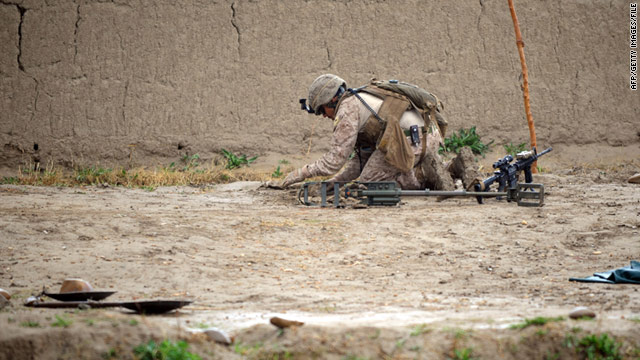Report: War-related civilian deaths up in Afghanistan

- U.N. in Afghanistan cites "dramatic growth" in civilian deaths
- Killings and injuries persist at "an alarming rate," a U.N. official says
- May was the deadliest month ever for civilians
(CNN) -- The use of powerful improvised explosive devices -- IEDs -- by militants in Afghanistan has caused a "dramatic" hike in "conflict-related civilian deaths" in the first half of the year, the U.N. Assistance Mission in Afghanistan said in a report Thursday.
The war-weary nation "experienced a 15 per cent increase" mainly because of "the use of landmine-like pressure plate improvised explosive devices by anti-government elements," according to the UNAMA's Mid-year Report on Protection of Civilians in Armed Conflict.
There were 444 victims of IEDS, "the single largest killer of Afghan civilians in the first half of 2011," the cause of 30% of all civilian killings.
"Afghan children, women and men continue to be killed and injured at an alarming rate," said Staffan de Mistura, special representative for Secretary-General Ban Ki-moon.
The violence shows no sign of lessening. Authorities in Khost province are investigating reports that six civilians were killed in a NATO-led night raid on Wednesday.
Six others were killed on Thursday in Kandahar by a suicide attacker at a mosque where several high-ranking Afghan officials had gathered to remember the slain half-brother of President Hamid Karzai.
UNAMA counted 1,462 civilian deaths in the period, with 80% attributed to anti-government elements. That's an increase of 28% in civilian deaths linked to militants from the same period last year.
The report attributed 14% of civilians deaths to pro-government forces, down 9% from the same period last year. The report said 6% of civilian deaths were not tied "to any party in the conflict."
There were 368 civilian deaths in May, the deadliest month for civilians since UNAMA started documenting civilian casualties in 2007. In June, 360 deaths were documented, 308 of which were tied to "anti-government elements."
Also in June, there was an "all-time high in the number of security incidents in a single month" and the highest-ever number of IED attacks recorded in a month.
The report, which labels militant forces anti-government elements, said the violence jumped as security responsibility transitioned from international to Afghan troops in different parts of the country.
"Combined with the efforts of various armed groups to undermine peace and reconciliation and intensified fighting between the conflicting parties, Afghans experienced a decrease in protection," the report said.
The report cited a "shift in anti-government tactics" that worsened the problem.
"In 2011, Anti-Government Elements expanded their use of unlawful means of warfare, particularly victim-activated pressure plate IEDs that act like anti-personnel landmines and cannot distinguish between a military target and a civilian," said Georgette Gagnon, director of Human Rights for UNAMA.
"This tactic violates Afghans' basic right to life and contravenes the international humanitarian law principles that all parties to the conflict are bound to uphold to minimize civilian loss of life and injury."
UNAMA notes that "two-thirds of all IEDs used in Afghanistan, and the vast majority that kill civilians, are designed to be triggered by a weight of between 10-100 kilograms," the weight of a human and in many cases the weight of a child.
"Any civilian who steps on or drives over these IEDs has no defense against them and little chance of survival," said Gagnon. "Any use by Taliban members of these pressure-plate IEDs violates the 1998 Taliban ban on any type of landmines. UNAMA calls on the Taliban to publicly reiterate a ban on these."
IEDs and suicide attacks accounted for nearly half of all civilian deaths and injuries in the first six months of 2011. Civilian deaths caused by IEDs rose 17% over the same period in 2010.
As for deaths by pro-government forces, airstrikes by NATO's International Security Assistance Force remained are the leading cause of death, with an "increasing proportion resulting from attacks by helicopters." Seventy-nine Afghan civilians died in airstrikes, a 14% increase compared to the previous year.
The number of targeted killings by anti-government forces was 191, up from 181 last year.
UNAMA called for anti-government elements to employ the "meaning of 'civilian' that is consistent and in compliance with their obligations under international humanitarian law." Civilians are people who aren't combatants or "members of organized armed groups of a party to the armed conflict," it said.
UNAMA had recommendations for all parties.
It urged "anti-government elements" to stop using the pressure-plate IEDs, stop attacks on hospitals, develop codes of conduct that prompt its members to prevent civilian casualties.
The agency called for international military forces to investigate why civilian casualties from helicopters are going up, review its night raids directive, and make sure that forces are properly trained in "escalation of force procedures."
It urged the Afghan government to investigate and properly track civilian casualties in order to "provide lessons learned and to improve civilian protection, compensation, and accountability."
